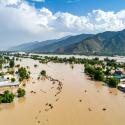Pakistan Floods
{{ facet.title }}
Pakistan: Flash Floods - 2025
Situation Overview
Pakistan is experiencing one of its most severe climate-induced disasters in recent history. Following a record-breaking spring heatwave, the 2025 monsoon season has brought torrential rains and accelerated glacial melt, triggering widespread flash floods and landslides. Communities have been cut off, homes destroyed, and farmland inundated, creating a humanitarian emergency across multiple provinces.
According to the National Disaster Management Authority (NDMA), since 26 June 2025 as mid-September 2025, the monsoon rains and floods have claimed about 972 lives, injured 1,062 people, destroyed or damaged 8,481 houses, and damaged 239 bridges and 674.58 km of roads.
HCT Updates:
The attached analysis covers flood-affected areas between 26 August – 7 September, including water extent detected with higher confidence (pixels with more than 80% water fraction). Please feel free to share this with partners.
- Data link: https://unosat.org/static//unosat_filesystem/4197/UNOSAT_PopulationExposure_FL20250818PAK_26Aug2025…
Punjab
Punjab remains at the epicenter of the emergency, with dangerously high water levels in the Chenab, Sutlej, and Ravi rivers. The Chenab at Trimmu is above 543,000 cusecs, while the Panjnad carries over 600,000 cusecs. The Sutlej at Ganda Singh Wala is in extreme flood at 319,000 cusecs, and the Ravi continues to surge at Balloki and Sidhnai with flows of 157,000 and 97,000 cusecs. Fueled by heavy monsoon rains and upstream releases from India, the floods have submerged thousands of villages in Muzaffargarh, Multan, Kasur, Okara, and Bahawalnagar.
To date, over 5.1 million people have been affected, 1.9 million evacuated, and more than 1.05 million acres of farmland inundated.
Sindh:
Sindh remains under medium flood risk, with conditions expected to persist for the next 12–24 hours. In District Dadu’s Kachha area, continuous rainfall since 10 September has caused flash floods up to 10 feet deep, cutting off road access to Johi and nearby villages. Rising Indus River levels, activation of the Nai Gaj hill torrent, and advancing waters toward Manchhar Lake are creating a dangerous multi-hazard scenario. Authorities estimate 178,000 people are at high risk in Kachho and around northern Manchhar Lake. In Karachi, heavy rains have intensified urban flooding, damaging infrastructure and drainage systems. Over 500 people have been rescued, and four relief camps have been set up in schools to provide emergency shelter.
Balochistan:
Flash flood alerts remain in place, particularly in districts bordering Punjab and Sindh. Heavy rains across the Sulaiman Range and adjoining hill systems continue to trigger floodwaters in seasonal nullahs, posing high risks of road closures, landslides, and damage to fragile infrastructure. Low-lying areas in Nasirabad, Jhal Magsi, Lasbela, and Khuzdar remain highly vulnerable as rainfall continues across southern and western parts of the province.
Rapid Needs Assessment (RNA):
The RNA has been initiated in Punjab. As of 10 September, data collection has been completed or is underway in eight districts: Sialkot, Muzaffargarh, Kasur, Multan, Bahawalpur, Chiniot, Narowal, and Jhang. Five additional districts (Okara, Bahawalnagar, Hafizabad, and Gujrat), assessments are scheduled to begin today.
Most Affected Regions (Monsoon-2025, Pakistan):
-
Khyber Pakhtunkhwa (KP): Buner, Swat, Shangla, Mansehra, Abbottabad, Lower Dir, and other mountainous & forested districts. OCHA+3ReliefWeb+3ReliefWeb+3
-
Punjab: Districts along the Ravi, Sutlej, and Chenab rivers – especially Multan, Muzaffargarh, Jhang, Layyah, and other central/southern districts. OCHA+3AP News+3ReliefWeb+3
-
Sindh: Low-lying (“downstream”) riverine belt, particularly areas along the Indus as flood waters propagate downstream; districts being evacuated proactively. AP News+1
-
Balochistan: Southern and coastal districts, particularly low-lying/rural districts where heavy rains are expected; risk remains for flash floods and related events. ReliefWeb+2ReliefWeb+2
-
Also significantly affected: Azad Kashmir and Gilgit-Baltistan have been noted in several reports as being under threat or being impacted in the northern mountainous areas. ReliefWeb+1
- Pages:
- {{ p+1 }} {{ p+1 }} …
| Document title | Size | Date |
|---|---|---|
| [ {{ document['field_file_file_size']|file_size }} ] {{ document.file_extension }} LINK | {{ document.date }} |

